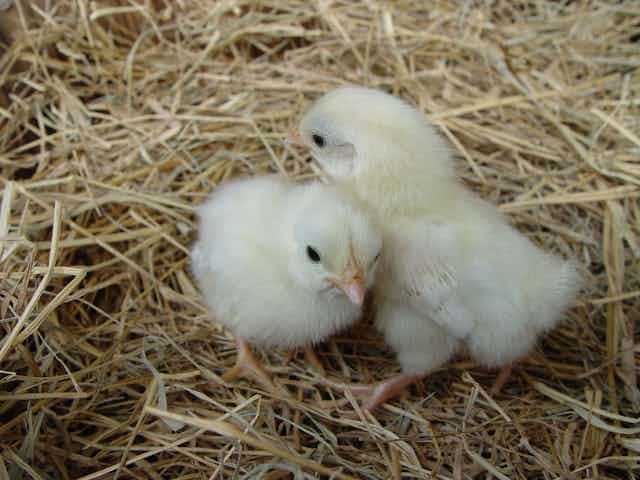This is an article from I’ve Always Wondered, a series where readers send in questions they’d like an expert to answer. Send your question to alwayswondered@theconversation.edu.au.
Can two chicks be born from a double-yolk egg? - Megan, Berry, NSW
Have you ever wondered how an egg gets to be that layered marvel of yolk inside a membrane, inside albumen inside more membranes and all topped off with a shell?
As wonderful (and complicated) as eggs are, it’s no surprise that they can come out a little odd from time to time. One of the most striking variations is the rare fertilised double-yolk – and yes, this can result in two chicks being born from the same egg.
Oddities like double-yolkers, as well as eggs with no shells, no yolk or even double shells, occur when something disrupts the usual egg-making process.
How eggs are made
Eggs depend on a really interesting organ called an oviduct.
First of all, a hen’s ovary produces an ovum. (That’s ovary as in singular – except in some raptors, the kiwi and a few other birds here and there, most birds have a single ovary.) The ovary looks like a cluster of tiny grapes, and if you care to dissect a bird, it’s located near the backbone, usually between or on top of the kidneys.

That ovum travels into the oviduct, which is a long and elastic tube that travels in a convoluted way from the ovary to the cloaca (the hole that birds defecate from). Muscle contractions move the ovum through the oviduct and first it enters a section where glandular secretions lay down the albumen (the white of the egg) in four layers.
Next, the egg enters the isthmus (a long narrow tube) of the oviduct, where two membranes are laid down: one to enclose the albumin and one to attach directly to the shell.
Then pigments are laid down. All the egg colours you might see, from random spots and speckles to uniform blue or brown, are actually the product of two colours. There’s buliverdin, which is responsible for blue-green hues, and protoporphyrin, which accounts for brownish reds, all mixed together to make the stunning array of bird’s eggs out there.

Finally the hard shell is laid down in the uterus, or shell gland, and consists of calcium carbonate in the form of crystals. Magnesium and phosphate are also included, but in small quantities. This whole process can take between 24 hours and a week depending on the species.
A delicate balance
Even the smallest differences in chemical composition of the shell can change the appearance and strength of the shell. If something goes wrong here, then you get abnormal eggs. There are lots of abnormalities possible in eggs such as:
Extra calcified shells: Variously termed dusted, white banded, chalky or pink, these seem to happen when an egg gets a little stuck in the oviduct during the time it rotates in the vagina, and gets an extra helping of calcium. Often makes the shell lumpy and bumpy.
Double shells: These are very rare and poorly understood. My best guess, based on my research and observation, is that the egg goes through the uterus as normal, then instead of being laid, is sucked back up into the uterus to go through the whole process again.
No shells: Eggs with no shells – only the membrane – are also very unusual. They’re thought to occur when the muscle contractions in the oviduct are too fast and the egg literally flies through without a stop at the shell gland for some shell. I’ve seen this in the wild in seabird colonies, once or twice, like someone cracked an egg and just left with the shell.
Insufficient shells: Eggs with really soft shells are due to a lack of calcium in the diet. It’s not only chickens that are desperate for calcium. There have been many instances of wild birds seen eating seashells, presumably in an effort to make egg shells without stripping the calcium from their own bones.
No-yolk eggs: Also called dwarf or runt eggs, they are usually less than half the size of normal eggs. They are the result of stimulation of the oviduct by a foreign object, like a blood clot. Just like a pearl is made by an oyster wrapping a bit of sand in layers and layers of calcium carbonate, the same can happen in an oviduct.
Double yolk eggs: These extra large eggs are very impressive, and some producers have even selectively bred for double-yolkers. They are created when two yolks are ovulated within a couple of hours of each other, like twins, so they end up travelling through the oviduct together. They’re most common when chickens start laying, before their system settles into a steady groove, but as the double yolk chicken breed shows, can be bred for. If both the ovum in the yolk are fertilised, they can both become viable (if a bit squashy) chicks.
Pretty cool, eh?

